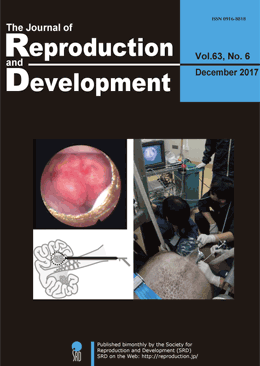Volume 63, Issue 6
Displaying 1-12 of 12 articles from this issue
- |<
- <
- 1
- >
- >|
SRD Innovative Technology Award 2016
-
Article type: SRD Innovative Technology Award 2016
2017Volume 63Issue 6 Pages 527-538
Published: 2017
Released on J-STAGE: December 15, 2017
Advance online publication: October 15, 2017Download PDF (5179K)
Original Article
-
Article type: Original Article
2017Volume 63Issue 6 Pages 539-545
Published: 2017
Released on J-STAGE: December 15, 2017
Advance online publication: August 20, 2017Download PDF (809K) -
Article type: Original Article
2017Volume 63Issue 6 Pages 547-554
Published: 2017
Released on J-STAGE: December 15, 2017
Advance online publication: August 31, 2017Download PDF (882K) -
C-X-C chemokine receptor type 4 (CXCR4) is a key receptor for chicken primordial germ cell migrationArticle type: Original Article
2017Volume 63Issue 6 Pages 555-562
Published: 2017
Released on J-STAGE: December 15, 2017
Advance online publication: September 01, 2017Download PDF (4326K) -
Article type: Original Article
2017Volume 63Issue 6 Pages 563-570
Published: 2017
Released on J-STAGE: December 15, 2017
Advance online publication: September 08, 2017Download PDF (3553K) -
Article type: Original Article
2017Volume 63Issue 6 Pages 571-580
Published: 2017
Released on J-STAGE: December 15, 2017
Advance online publication: November 07, 2017Download PDF (2721K) -
Article type: Original Article
2017Volume 63Issue 6 Pages 581-590
Published: 2017
Released on J-STAGE: December 15, 2017
Advance online publication: October 06, 2017Download PDF (1466K) -
Article type: Original Article
2017Volume 63Issue 6 Pages 591-595
Published: 2017
Released on J-STAGE: December 15, 2017
Advance online publication: October 12, 2017Download PDF (744K) -
Article type: Original Article
2017Volume 63Issue 6 Pages 597-604
Published: 2017
Released on J-STAGE: December 15, 2017
Advance online publication: October 27, 2017Download PDF (1003K)
Technology Report
-
Article type: Technology Report
2017Volume 63Issue 6 Pages 605-609
Published: 2017
Released on J-STAGE: December 15, 2017
Advance online publication: October 13, 2017Download PDF (1158K) -
Article type: Technology Report
2017Volume 63Issue 6 Pages 611-616
Published: 2017
Released on J-STAGE: December 15, 2017
Advance online publication: August 19, 2017Download PDF (1607K) -
 Article type: Technology Report
Article type: Technology Report
2017Volume 63Issue 6 Pages 617-622
Published: 2017
Released on J-STAGE: December 15, 2017
Advance online publication: October 14, 2017Editor's pickCover Story :
Okuyama et al. reported a transvaginal endoscopy-based technique for conducting ovarian examination in sows in a standing position. Sows were sedated in pig stalls, and their vaginal walls were punctured. Subsequently, a urethroscope was inserted into their abdomen, and an examination was conducted after their ovaries had moved towards the urethroscope camera via rectal palpation (Okuyama MW, et al. A transvaginal endoscopy-based technique for performing ovarian examinations in sows. pp. 617–622). This less invasive procedure without the use of general anesthesia may allow repeated ovarian examinations and increase our understanding of the ovarian dynamics in pigs.Download PDF (1819K)
- |<
- <
- 1
- >
- >|
